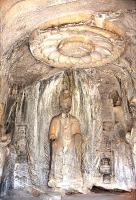CONTACT US
| +86-10-82600771 | |
| WhatsApp: +86-13911460247 | |
| Messenger: chinatournet | |
WeChat ID: callchinatour | |


Spanning a length of over 1,000 meters on the hillsides
along the Yi River, the Longmen Grottoes, together with the Mogao Caves in
Dunhuang (Gansu Province) and the Yungang Grottoes (Shanxi Province), are known
as the three greatest stone sculpture treasure houses in China. In the year
2000, Longmen Grottoes was listed by UNESCO as a World Cultural Heritage Site.
It is located 12km south of Luoyang.
Exquisitely caved and beautifully shaped with a vivid and delicate appearance,
the Longmen Grottoes are known as a bright pearl in the artistic treasure house
of the sculptures of the world.
The Longmen Grottoes
were first sculptured and chiseled around 493 AD when the Northen Wei Dynasty
moved its capital from Datong to Luoyang. It took more than 400 years to
complete the entire construction of Longmen Grottoes through the Northern
Dynasties, Sui Dynasty, Tang Dynasty and up to Song Dynasty. Today, there are
still 2345 caves and niches, 100,000 Buddhist images ranging in size from 2 cm
to 17.14 meters, more than 2800 inscribed tablets, and 43 Buddhist pagodas
remaining in both East Hill and West Hill. Altogether 30 % date from Northern
Wei Dynasty, 60 % from Tang Dynasty and the rest 10 % from other periods.
Three Binyang caves

The main Longmen Grottoes honeycomb the cliff face on Yi River's western bank and stretch for 1 km on a north-south axis. The three Bingyang caves are at the northern end which are closest to the entrance. Construction began on all three under the Northern Wei dynasty. Although two were finished during the Sui and Tang dynasties, the statues all display the benevolent expressions that characterised the Northern Wei style.
Ten Thousand Buddha Cave

South of Three Binyang Caves is the Tang dynasty Ten Thousand Buddha Cave which was built in 680 AD. In addition to the incredible legions of tiny bas-relief Buddhas that give the cave its name, there is a fine, big Buddha and images of celestial dancers.
Lotus Flower Cave

This cave was carved in AD 527 during the Northern Wei dynasty and has a large standing Buddha, now faceless. On the ceiling are wispy apsaras(celestial nymphs) drifting around a central lotus flower. A common symbol in Buddhist art, the lotus flower represents purity and serenity and can be seen on many of the cave ceilings.
Fengxian Temple



Carved in the Tang dynasty between AD 672 and 675, this is
the largest structure at Longmen and contains the best works of art. Today the
roof is gone and the figures lie exposed to elements. Tang figures tend to be
more three-dimensional than the Northern Wei figures, standing out in high
relief and rather freer from their stone backdrop. Their expressions and poses
also appear to be more natural, but unlike the other-worldly figures of the
Northern Wei, the Tang figures are meant to be awesome.
The seated central Buddha is 17m high and it is said to be Losana. Allegedly,
the face was modelled on Empress Wu Zetian of the Tang dynasty who funded the
carving of the statue.
To the left as you face the Buddha,
are statues of the disciple Ananda and a Boddhisattva wearing a crown, a tassel
and a string of pearls.
To the right are statues of
another disciple, a Bodhisattva, a heavenly guardian trampling on a spirit and a
guardian of the Buddha.
Medical Prescription
Cave
South of Fengxian Temple is the tiny Medical
Prescription Cave. The entrance to this cave is filled with 6th-century stone
steles inscribed with remedies for common
ailments.
Earliest
Cave
Adjacent to the Medical Prescription Cave is
the much larger Earliest Cave, carved between AD 495 and 575. It's a narrow,
high-roofted cave featuring a Buddha statue and a profusion of sculptures,
particularly of flying apsaras. This was probably the first cave of the Longmen
group to be built.
Carved Cave
This
cave was carved druing the Northern Wei dynasty. This is the last major cave in
the Longmen complex and features intricate carvings depicting religious
procession.
During the history, some parts of Longmen Grottoes were destroyed by erosion and vandalism. Numerous crevices in the rock bases cause some caves to become unstable or even to collapse, thus damaging the sculptures. Saline sediments resulting from acid rain, train and automobile vibrations and natural disasters have also affected the site. To protect the valuable treasure house, the central and local governments are endeavoring to improve the environment of the the scenic area.
Two days tour + hotel package for Longmen Grottoes in Luoyang city, from $144, check details...